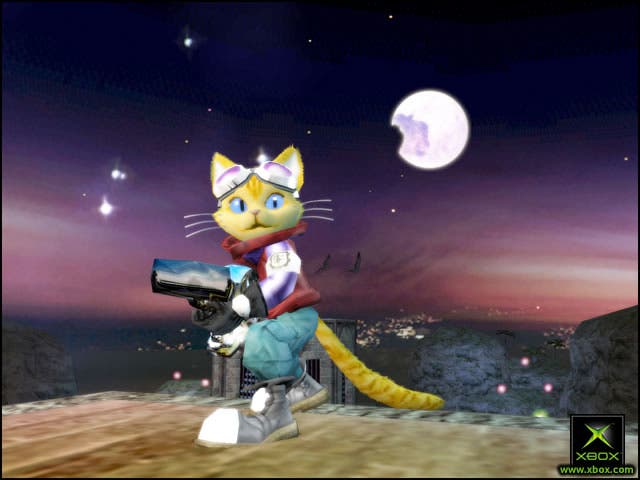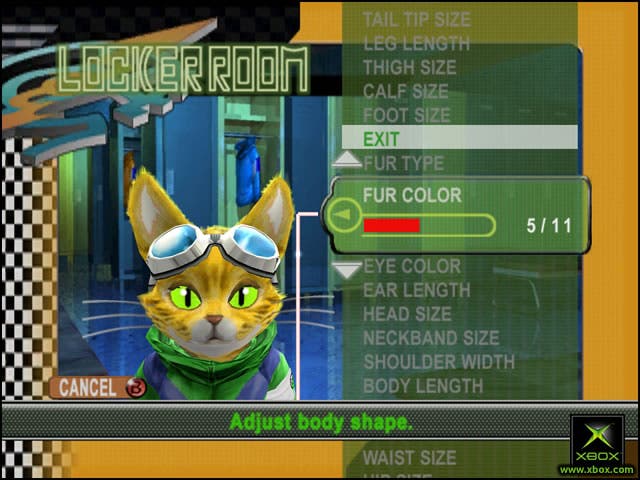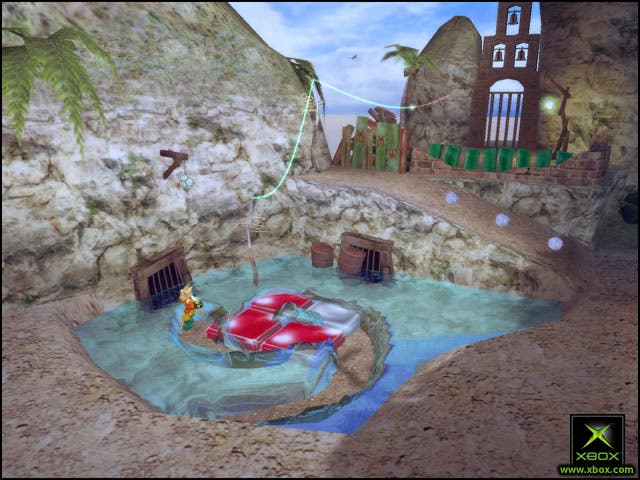Blinx 2: Masters of Time & Space
Erase and rewind.
Above the newspaper article was a photograph of a large cat. Leaping into the air, its eyes were fixed on a baby wren, the poor bird desperately trying to escape its claws. The ferocity of the cat was plainly evident. Its gaze was the merciless gaze of a hunter. The helpless wren didn't stand a chance. Even though the photograph had frozen the bird in a moment of escape, you knew what was really coming next ... *swish*, *squawk*, *gulp*, *burp*.
But isn't that the way of the world? Dog eat dog, cat eat bird, and all that? Perhaps so, but in this case that adage had been taken a little far. The newspaper article in question explained how the population of wren in an Australian town had been wiped out by household cats, citing the lack of protein in tinned food as the reason for their excessive hunting.
Cats, it seems, like their food with a little meat on it.
The same can be said for gamers and their games. If you offer us a portion of bland if pleasantly packaged platforming, you can't be surprised if we turn our noses up at it and feast on the likes of Ratchet & Clank instead. And while 2002's Blinx certainly had a distinctive flavour, it was soured by a shoddy camera and some needlessly frustrating gameplay. 'Missed opportunity' was how most critics labelled it, though some weren't so kind.
There's no healer like time...

Well, Blinx 2: Masters of Space & Time makes one thing very clear: developer Artoon listened to the criticism. The camera problems that plagued the first game aren't problems any more, the silly time limit on missions has been lifted, the highly enclosed level design is a thing of the past and, overall, the game is much less frustrating. In other words, Artoon resolved most of the issues that supposedly prevented Blinx from being a success... the question is, does it make a difference?
During the game's early moments, the outlook wasn't good. For a start, the initial story sequence - involving the shattering of a powerful time crystal, the 'Big Crystal' - was about as compelling as my dad's toenails. The prospect of playing as Blinx's enemies, the porcine Tom Tom gang, for half the game wasn't exactly tickling my chops either. Then there was the dreaded character creation screen, a sure-fire sign (or so I thought) that Blinx 2 would be even more soulless than its predecessor in the personality stakes. One of the complaints about Blinx was his complete lack of charisma, and having players create their own character this time around smelled of a cop-out.
As it happens, the character creation is actually one of a few clever additions to Masters of Time & Space. While it does bypass the issue of creating a decent lead character for the game, it also makes the experience immediately personal, giving you a fairly in-depth selection of choices to make about your lead feline's size, colour and weight. This is the same kind of thing that Jedi Academy did last year, except in this case the customisation is only visual.
By a whisker
Of course, none of that matters much if the gameplay hasn't been given a facelift of its own. Your customised hero plays exactly the same as Blinx did and, just like Blinx, is a Time Sweeper. That means he can control events using time crystals, which give him the ability to pause, rewind, fast-forward, record and slow down gameplay. In the first game, this wasn't exactly as fun as it sounds, mainly because you had to vacuum up three of the same type crystals in a row in order to gain their power. If you sucked up the wrong one, you had to start the process again. This vacuum action was more like a Cautious Maid Simulator(TM) than a platform game, and the silly camera really didn't help.
In Blinx 2, this process has been rightfully changed. Now you can suck up time crystals in any order and they will simply stack up until you have enough to make a power. It makes for a much more comfortable experience, but I couldn't help feeling that one of Artoon's original aims for the series (incorporating the vacuum into delicate gameplay) had been watered down and pushed to the side. So while one of the frustrations from the first game had thankfully disappeared, I might as well have walked over the time crystals - like in most other platformers - instead of hoovering them up.
Jack of all trades, master of... well, time and space actually.

Masters of Time & Space soon makes it clear that, at heart, it just wants to be like 'most other platformers'. Having been hurt by Blinx's rejection, the sequel sets out to assimilate various gameplay types and conform for the masses.
In many ways, this is a good thing. For example, in the Time Sweeper mode we now get small, but fairly well designed levels that rely on a mixture of jumping, shooting and light time puzzling. Usually, the overall mission objective is to retrieve a shard of the Big Crystal, and often there are two routes to the goal, though the routes don't vary much. For instance, in one level you are challenged to either press a number of switches in the area, or destroy a number of statues by shooting them. There's no real explanation for the choice, but either way the end result is pretty much the same.
Time not well spent
While the time controls come into play frequently, they are never particularly satisfying. Pausing the gameplay in order to shoot super-fast enemies is only fun once, after that it has nothing to do with skill or thought, because they are bloody immobile. The same goes for speeding up time so you can jump farther, slowing it to avoid fan blades and, especially, reversing time to 'mend' broken switches and the like. None of it is ever very satisfying. Even the Bullet Time moments, where you have to press X or Y in order to dodge or freeze surprise events, rarely contribute to the gameplay and are never a challenge.
While the basic problems of the first game have been eliminated, they were basic problems nonetheless. Resolving them is only a step in the right direction, not a guarantee of good gameplay. However, in one area - that of shooting - the problem has been dealt with brilliantly. You still suck in debris by holding the right trigger, and then fire it out by tapping the same trigger. The left trigger now gives you the option of locking on to enemies, but it's rubbish because the lock isn't firm - in other words, you 'pull away' from the target just by moving backwards. The real treat is the first-person mode, which controls just like a standard FPS and lets you shoot, jump and (in theory) play from this perspective most of the time. Without this, Blinx 2 would probably be two pieces of snapped disc on my living room floor.
Isn't one Tom enough!?

The biggest addition to the game is the Tom Tom side of the story. You control these pigs [oi -Tom] (well, they are) every second mission and the experience is somewhat different to the time-sweeping section, though not so different from other games I won't mention. While the viewpoints and basic controls remains the same for these guys, their objectives and abilities differ radically from the cats.
Essentially, these pigs want to be snakes. Or should I say, these pigs want to be Snakes. Their missions revolve around stealth and sneaky activities and, like the Sweepers, they have a number of powers that help them out. While the cats can pretty much run around their levels without fear, the Tom Toms need to be more cautious, using cloaking devices to slip past guards and luring the opposing Time Sweepers into portals to make areas safe. However, they also have a large selection of projectile weapons - which can be bought between levels after a while - and these can sometimes make the sneaking aspect less than necessary.
The reason the Tom Toms are stealthy is because they like to steal stuff, which leads to the majority of their puzzles. Once you get your hands on their treasure objective, it transforms into a loot bag that you can only lug around. Double-jumping, running and shooting aren't possible with loot on your back, so you must find a way to transport items back across levels by way of powers and switches.
However, again, none of these scenarios are ever very challenging and rarely make innovative use of the powers at hand. That's not to say I didn't enjoy doing them but, to give an example, arranging mirrors in order to reflect light at a certain point is very old now. In fact, it was old in Jak & Dexter, older in Prince of Persia, and just plain exasperating here.
Take a hint. We said TAKE IT!
If I sound jaded regarding the puzzles in the game, then there is another very good reason for this. Blinx 2 has one very major flaw - incessant hints. Walk into a room and within five seconds you will be told what to do next, even with the most basic puzzles. You don't even get time to look at the scenery. Initially I presumed this to be extended tutorial work, but it continued throughout most of the game. I'd love to have played Blinx 2 the first time through without these hints because it might have been a bit of fun, if slightly frustrating, to figure out which powers to use in certain situations. For the most part, they were fairly obvious, but in certain cases it might have been satisfying to find out through trial and error. Heck, isn't that what games are about?
This only reinforced my opinion that Blinx 2 has been 'dumbed down' from the original's premise. While there's nothing wrong with simple gameplay (it's the best kind, most of the time), there's a fine line between mediocrity and simplicity. Perhaps the biggest problem with this series is identity: extensive time control is suited to an out-and-out puzzle game, not a platformer. Sands of Time placed the emphasis firmly on the latter aspect, with time-control as a complimentary element.
So while the first Blinx appeared to be a missed opportunity, maybe it was never an opportunity in the first place. Maybe the idea just sounds better than it could ever really be implemented.
Glimpses of the past

For its part, Artoon shows glimpses of its Sonic Team heritage. The boss battles, for example, are good fun. Think Zelda-lite or, considering the first-person view, Metroid Prime-lite. The second one is my favourite, where you have to use the rewind power to revert a giant plant back to 'bud' form so you can whack it with the new melee attack.
The co-op and deathmatch modes are also welcome additions. The latter lets up to four players go at it in fairly straightforward showdowns, while the former allows you to play through the single-player mode with slightly different puzzles. To be honest, I didn't spend too long with that section (mainly because my friend was both unwilling and crap) but I can't imagine many people will anyway, especially having played through the single-player first. Nonetheless, credit to the developers for implementing it at least.
The graphics are all but unchanged from the first game, though the customised characters look a little suspect when moving, as if they aren't entirely comfy in their bodies. I must mention one scene in particular, however, and that is the first Tom Tom level, where you begin on a stormy night down by a pier. The combination of the storm, rain and unbelievable waves made it one of my favourite graphical moments of the year. Unfortunately, the same standard of atmosphere doesn't apply across the board and, aside from some nice reflective surfaces, it's a case of blinx and you'll miss it [oof! - Ed].
The soundtrack, on the other hand, is probably the game's most consistent feature. It's certainly no Yasunori Mitsuda, and I wouldn't really want to hear it outside of the game, but the (generally) boppy music reminded me of Super Monkey Ball, only less annoying.
Finally, while the plot is non-existent, special praise should go to some of the humour in the game, which is suitably quirky. The Tom Tom leader who falls in love is the embodiment of Saturday-morning cartoon baddies... completely harmless and sure to get a giggle from younger gamers.
The time has come
In fact, that last statement sums up Masters of Time & Space quite nicely. The potential that we saw in Blinx was perhaps unrealistic and unfair, but poor controls and design made the debate irrelevant. This time around, the controls and design are much better, but the overall result is just as underwhelming. While I enjoyed playing the game, there's no way I'd pay more than 15 quid for it. In saying that, it would make for a reasonable weekend rental, or a nice addition to a 12 year-old's stocking.
Television adverts tell us that nine cats out of ten prefer easily digestible tinned food. Still, I'm betting that nine gamers out of ten prefer to sink their teeth into something more substantial than Blinx 2.
